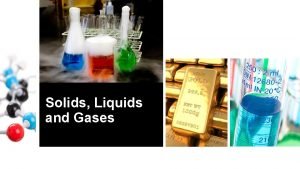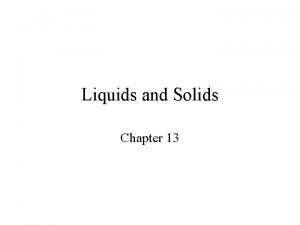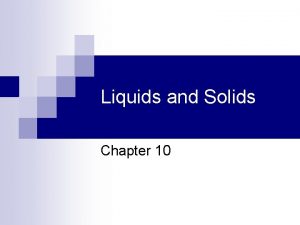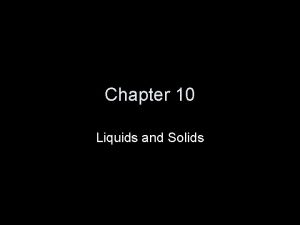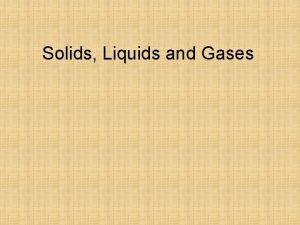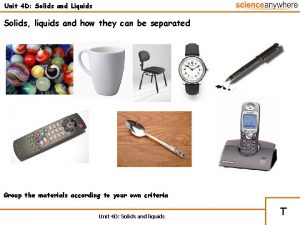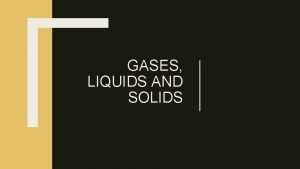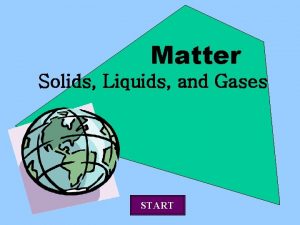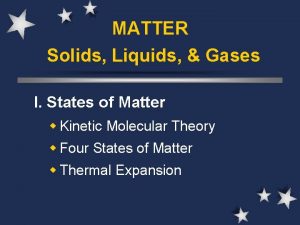Chapter 3 States of Matter Solids Liquids and













- Slides: 13

Chapter 3 – States of Matter Solids, Liquids and Gases (and more…)

Solids – a state of matter with a definite shape and definite volume. Shape and volume do not change unless you change them. Ex: Copper is a solid at room temperature.

Liquids – State of matter with definite volume but not definite shape. Liquids take the shape of the container in which they are placed. Example: Mercury is a liquid at room temperature.

Gases – State of matter with neither a definite shape or volume. Gases take up the volume and the shape of whatever it is placed in. Ex: Helium is a gas at room temperature.

Other States of Matter There are two other states of matter that will be discussed in a different powerpoint…

Kinetic Theory Kinetic energy – energy an object has due to motion. • The faster an object moves the more kinetic energy it has.

• Kinetic theory – all particles of matter are in constant motion. Example: Throwing a football – the solid particles in the ball are moving and so is the air the football travels through.

Behavior of Gases • Particles of gas are constantly colliding. They are always in motion. • Why don’t particles in a solid move as freely as particles in a gas at room temperature? ? ? • Think about blowing bubbles. What happens to the atoms inside the bubble? ? What can happen to the kinetic energy when they collide?

Particles in a solid answer: Atoms in a solid are packed tightly together so that motion is very limited. Actually the motion of a solid is more like a vibration. The atoms can not change place with other atoms unlike a liquid or a gas. Solid particles are Highly attracted to each other!

Bubble Answer • The atoms are in constant motion! Sometimes the atoms collide with each other or the sides of the bubble. Some atoms are moving faster than others. One atom may gain kinetic energy and speed up while the other atom loses kinetic energy and slows down.

Behavior of Liquids • Particles of a liquid are more closely packed than the particles of a gas. • There is a greater attraction by the particles due to the closeness of the particles. • The volume of a liquid is constant because forces of attraction keep the particles close together.

Behavior of Solids • Very strong attractions among the particles of a solid keep the particles vibrating around the fixed location. • Solids are in constant motion (vibrating). • Atoms vibrate in a solid but do not change places with other atoms.

Quiz 1. Which state of matter has a definite volume but a variable shape? 2. In which state can materials take the shape of their container? 3. True or False? The atoms in gas are arranged in an orderly pattern. 4. If the speed of an object increases, its kinetic energy ________.
 Chapter 11 - states of matter: liquids and solids
Chapter 11 - states of matter: liquids and solids Chapter 14 solids liquids and gases worksheet answers
Chapter 14 solids liquids and gases worksheet answers Kinetic molecular theory of solid
Kinetic molecular theory of solid Thermal expansion and contraction examples
Thermal expansion and contraction examples Solids liquids and gases section 2 properties of fluids
Solids liquids and gases section 2 properties of fluids Properties of solids and liquids
Properties of solids and liquids Diagram states of matter
Diagram states of matter What are the properties of solid
What are the properties of solid Process of liquid to gas
Process of liquid to gas Adhesive force
Adhesive force Liquids and solids menu
Liquids and solids menu The science duo physical and chemical changes
The science duo physical and chemical changes Kesler science.com
Kesler science.com Red liquid element
Red liquid element












